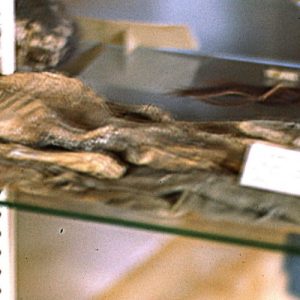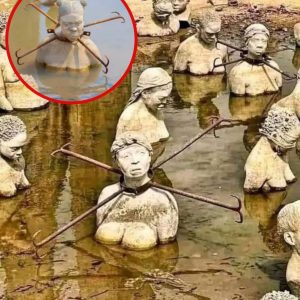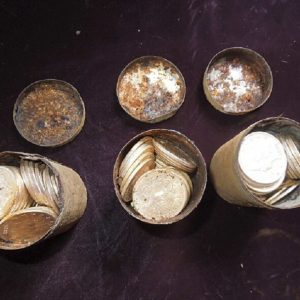Scientists and army engineers have pulled the fossilized remains of over 600 mammoth specimens from the ground, making the site the largest deposit of such fossils south of the La Brea Tar Pits.

A 15-foot alpha male mammoth waits to welcome the first visitors to the museum. Behind the big guy, a mural depicts what patrons might have witnessed here some 20,000 years ago: herds of his fellow mammoths drinking from the lake humans would eventually call Xaltocan alongside other now-extinct species of horses, camels, saber-toothed tigers, and the oversized armadillos called glyptodonts.
Workers discovered the first fossilized remains here just three weeks after construction began on the Felipe Ángeles International Airport in October 2019. In September 2020, the more than 200 Columbian mammoth skeletons discovered here earned the site the nickname “Mammoth Central.”

The count has risen to over 600 mammoth specimens, making the site the largest deposit of Pleistocene-era fossils south of the La Brea Tar Pits, according to Mexico’s National Institute of Archaeology and History (INAH).
Working alongside engineers from Mexico’s defense ministry SEDENA — which is in charge of the airport’s construction — scientists have so far excavated and registered 395 of the 560 individual discovery sites, and believe they are on schedule to open the Quinamétzin Paleontological Museum of Santa Lucía in March. The monumental gate at the entrance to the parking lot bears the Spanish translation of Quinamétzin, the word the Aztecs so aptly gave this land: Tierra de Gigantes. Land of Giants.
Vestiges of the ancient lake existed until the 1950s, when the Santa Lucía military base was built here about 25 miles northeast of downtown Mexico City. Xaltocan is now completely dry, the crystalline water, ancient megafauna, and flocking waterfowl replaced by a hotel, shopping mall, hospital, aviation museum, and the new airport, which is set to open in March as well.

“It was a paradise for these animals, but also a death trap,” said Major Jesús Cantoral, the army engineer overseeing what he described as an “unprecedented collaboration” between the military and scientists from a wide variety of fields. There are archaeologists and paleontologists to see to the bones, but they are just the tip of the iceberg.
Hard at work in the museum and adjacent research center are paleobiologists, vulcanologists, palynologists (dust scientists), ancient DNA specialists, expert fossil restorers, and edaphologists, whose specialization is how soil effects the living things that tread and put roots in it. Together they have determined that the mammoths flocked to the lake due to the availability of water and food. The gargantuan herbivores consumed over three tons of grass a week.

But while their size limited the number of predators that could make them prey, it also worked against them. The soil here is a dense clay that may have seemed solid enough to the thirsty mammals at first, but it often ended up trapping the 22,000-pound beasts where they stood. Cantoral and his team have found scores of mammoth feet in anatomically correct positions, while bones from the parts that didn’t get stuck in the mud are often found scattered at random due to opportunistic predators and other natural forces that scattered them about.
In addition to details gleaned from archaeological data points, scientists hope to determine a broad array of other facts about the animals that died here tens of millennia ago, including why they went extinct. In a statement from August 2021, INAH researcher Joaquín Arroyo-Cabrales said that taphonomic (dealing with the process of fossilization) and taxonomic studies “will allow [them] to arrive at the living animal in reverse.”
That means they can ascertain such biological features as the sex and age of a specimen and even group them into the herds with which they most likely grazed and traveled. These bones tell stories of the kinds of activities the mammoths took part in, including the nature of their interactions with other species, and scientists like Arroyo-Cabrales know how to read them.

Over the course of their 80-year lifespan, these creatures lost and replaced their massive molars up to five times. Modern elephant mothers, whose two-year gestation period is the longest among living land mammals, would surely be glad they do not have to undergo the epic 40-month pregnancies of their ancestors.
While it may seem only logical to have halted construction on the airport once the archaeological importance of the site was established, such a move would not have been beneficial for either the engineers or the scientists. Once unearthed, the fossils must be removed and preserved, or else they will disintegrate due to exposure to the elements.

So the team developed a systematic process of registering, recovering, and removing the bones in order to keep the pace of building, reshaping the awe of discovery into a quotidian procedure. They used the digital imaging method known as building information modeling to create digital renderings of each find that are exact to the millimeter.
With such expertise and state-of-the-art technology, they hope to solve the millennial mystery of what turned the Land of Giants into ancient history.





